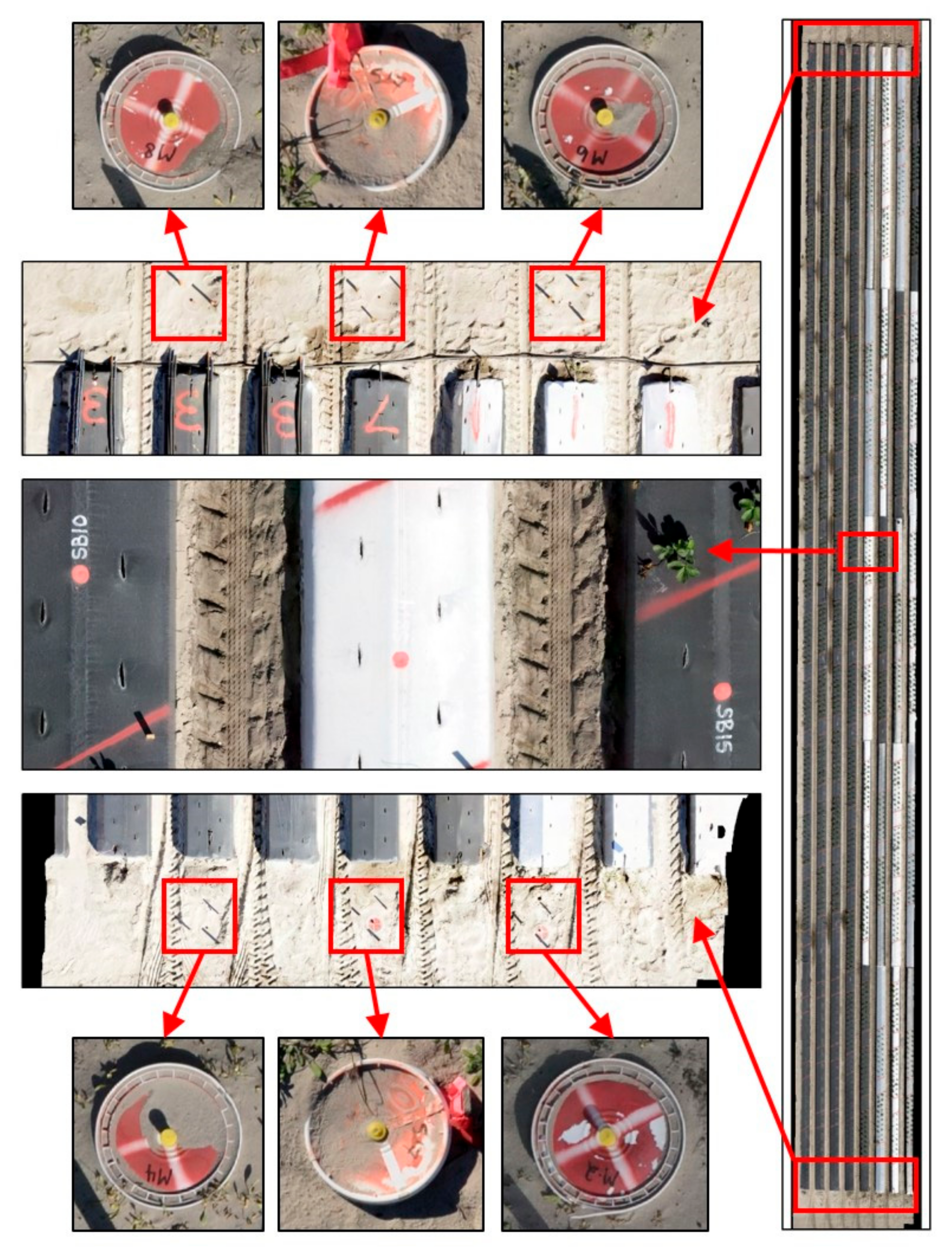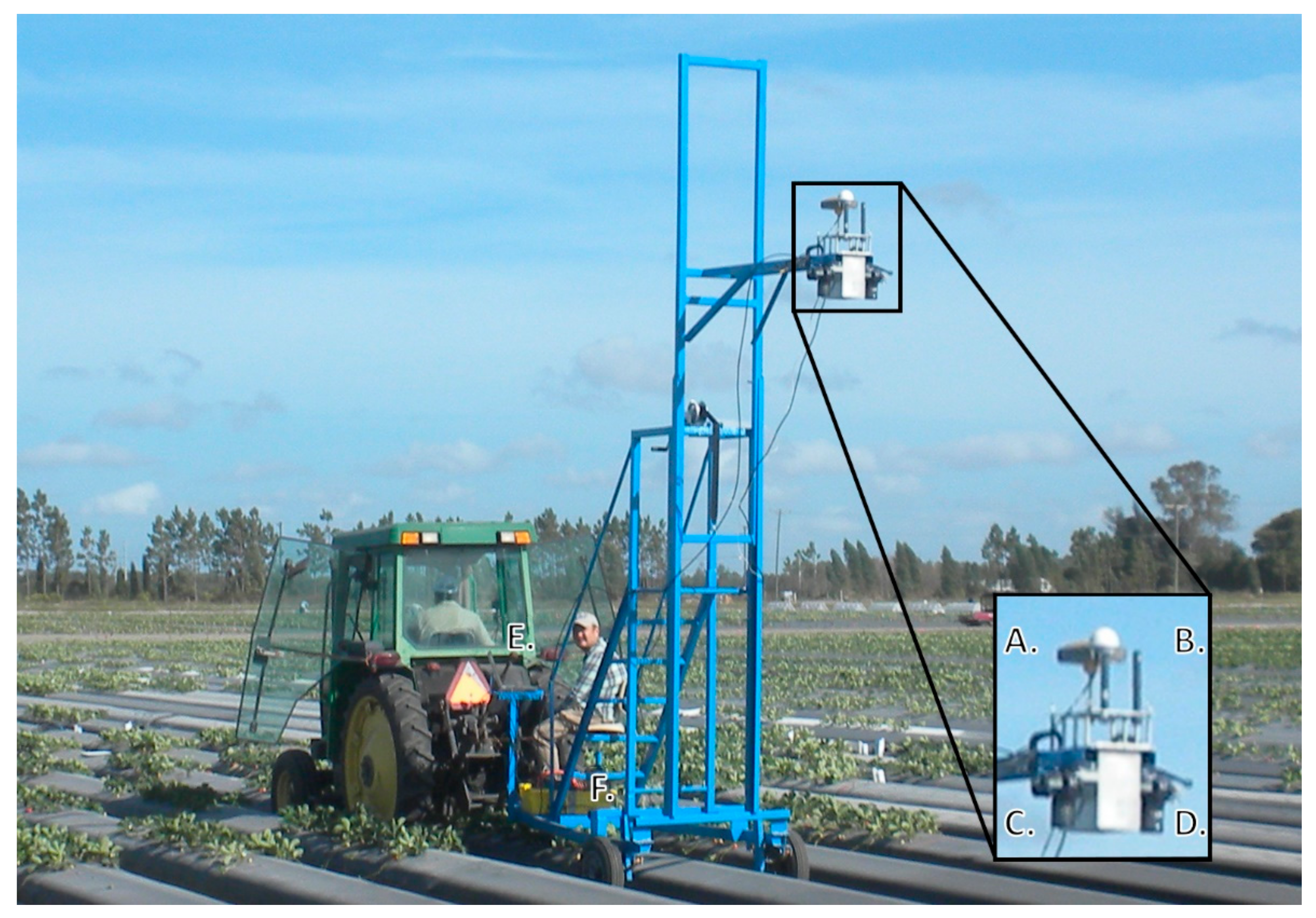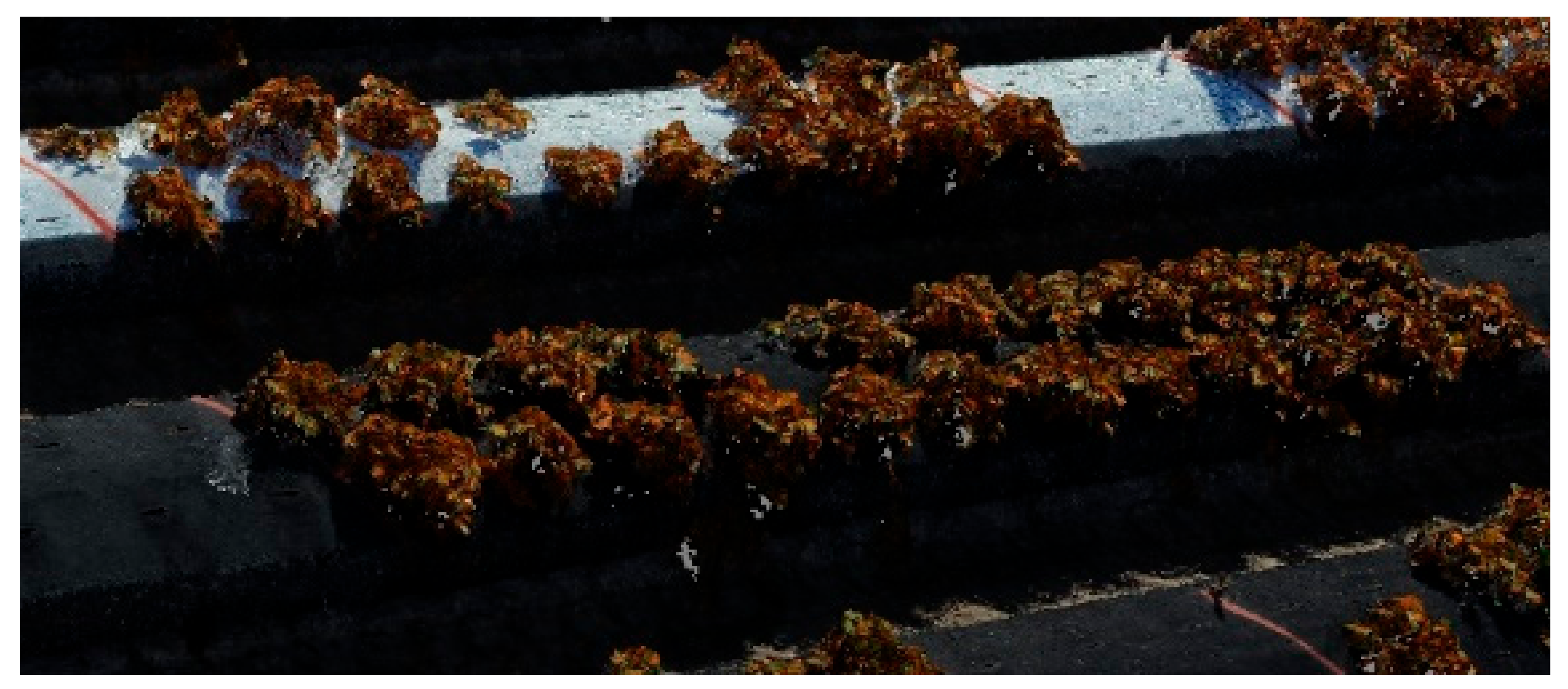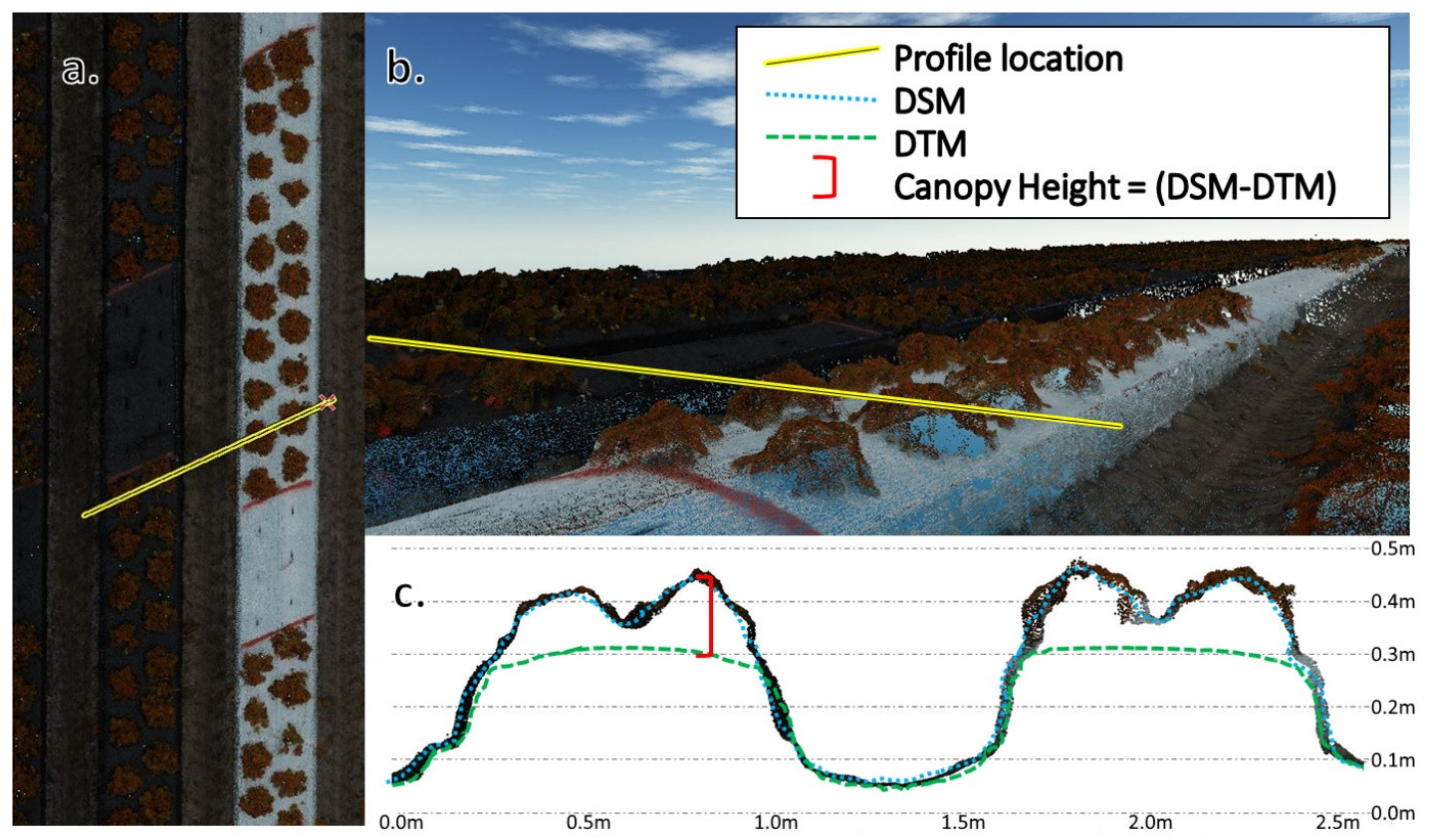Improving Strawberry Yield Prediction by Integrating Ground-Based Canopy Images in Modeling Approaches
Abstract
:1. Introduction
2. Materials and Methods
2.1. Study Site
2.2. Control Point Establishment and Image Acquisition
2.3. Image Pre-Processing
2.4. Strawberry Yield, and Flower and Fruit Count Data Collection
2.5. Weather Variables
2.6. Canopy Size Variables Extraction
2.7. Statistical Analysis Methods
3. Results
3.1. Image-Derived and Field-Observed Flower and Fruit Counts
3.2. Yield Prediction Based on Imagery, Weather, and Canopy Characteristics
4. Discussion
5. Conclusions
Author Contributions
Funding
Institutional Review Board Statement
Informed Consent Statement
Data Availability Statement
Acknowledgments
Conflicts of Interest
References
- Sanz, C.; Pérez, A.G.; Olías, R.; Olías, J.M. Quality of Strawberries Packed with Perforated Polypropylene. J. Food Sci. 1999, 64, 748–752. [Google Scholar] [CrossRef]
- MacKenzie, S.J.; Chandler, C.K. A Method to Predict Weekly Strawberry Fruit Yields from Extended Season Production Systems. Agron. J. 2009, 101, 278–287. [Google Scholar] [CrossRef]
- Tuovinen, T.; Parikka, P. Monitoring Strawberry Pests and Diseases: A Method to Estimate Yield Losses. Acta Hortic. 1997, 439, 941–946. [Google Scholar] [CrossRef]
- Palencia, P.; Martinez, F.; Medina, J.J.; López-Medina, J. Strawberry Yield Efficiency and Its Correlation with Temperature and Solar Radiation. Hortic. Bras. 2013, 31, 93–99. [Google Scholar] [CrossRef] [Green Version]
- Pathak, T.B.; Dara, S.K.; Biscaro, A. Evaluating Correlations and Development of Meteorology Based Yield Forcasting Model for Strawberry. Adv. Meteorol. 2016, 2016, 1–7. [Google Scholar] [CrossRef] [Green Version]
- Guan, Z.; Wu, F.; Whidden, A. Top Challenges Facing the Florida Strawberry Industry: Insights from a Comprehensive Industry Survey. EDIS 2016, 2, 3. [Google Scholar]
- Misaghi, F.; Dayyanidardashti, S.; Mohammadi, K.; Ehsani, M.R. Application of Artificial Neural Network and Geostatistical Methods in Analyzing Strawberry Yield Data. In Proceedings of the 2004 ASAE Annual Meeting, Ottawa, ON, Canada, 15 August 2004. [Google Scholar]
- Bartczak, M.; Lisiecka, J.; Knaflewski, M. Correlation between Selected Parameters of Planting Material and Strawberry Yield. Folia Hortic. 2010, 22, 9–12. [Google Scholar] [CrossRef] [Green Version]
- Lopez, A.; Perez, C.; Arias, A.; Palanco, J.; Gomez, A.; Torres, M.; Rodriguez, M. Strawberry Fruit Yield Forecast Based on Montecarlo Methodology and Artificial Vision. In Proceedings of the 7th International Strawberry Symposium, Beijing, China, 12 January 2019; pp. 551–552. [Google Scholar]
- Poling, E.B. Strawberry Plant Structure and Growth Habit. In Proceedings of the Empire State Producers Expo, New York, NY, USA, 12–15 January 2012. [Google Scholar]
- Jones, J.W.; Antle, J.M.; Basso, B.; Boote, K.J.; Conant, R.T.; Foster, I.; Godfray, H.C.J.; Herrero, M.; Howitt, R.E.; Janssen, S.; et al. Toward a New Generation of Agricultural System Data, Models, and Knowledge Products: State of Agricultural Systems Science. Agric. Syst. 2017, 155, 269–288. [Google Scholar] [CrossRef]
- Xu, Y.; Smith, S.E.; Grunwald, S.; Abd-Elrahman, A.; Wani, S. Effects of Image Pansharpening on Soil Total Nitrogen Prediction Models in South India. Geoderma 2018, 320, 52–66. [Google Scholar] [CrossRef]
- Zheng, C.; Abd-Elrahman, A.; Whitaker, V. Remote Sensing and Machine Learning in Crop Phenotyping and Management, with and Emphasis on Applications in Strawberry. Remote Sens. 2021, 13, 531. [Google Scholar] [CrossRef]
- Guan, Z.; Abd-Elrahman, A.; Fan, Z.; Whitaker, V.M.; Wilkinson, B. Modeling Strawberry Biomass and Leaf Area Using Object-Based Analysis of High-Resolution Images. ISPRS J. Photogramm. Remote Sens. 2020, 163, 171–186. [Google Scholar] [CrossRef]
- Abd-Elrahman, A.; Sassi, N.; Wilkinson, B.; Dewitt, B. Georeferencing of Mobile Ground-Based Hyperspectral Digital Single-Lens Reflex Imagery. J. Appl. Remote Sens. 2016, 10, 014002. [Google Scholar] [CrossRef] [Green Version]
- Abd-Elrahman, A.; Pande-Chhetri, R.; Vallad, G. Design and Development of a Multi-Purpose Low-Cost Hyperspectral Imaging System. Remote Sens. 2011, 3, 570–586. [Google Scholar] [CrossRef] [Green Version]
- Agisoft, L.L.C. Agisoft PhotoScan User Manual: Professional Edition. Available online: https://www.agisoft.com/pdf/photoscan-pro_1_4_en.pdf (accessed on 15 May 2020).
- Triggs, B.; McLauchlan, P.F.; Hartley, R.I.; Fitzgibbon, A.W. Bundle Adjustment—A Modern Synthesis. Int. Work. Vis. Algorithms 1999, 1883, 298–372. [Google Scholar]
- Caliper Mapping and Transportation Glossary. DEM. 1991. Available online: https://www.caliper.com/glossary/default.htm (accessed on 15 May 2020).
- Smith, G. Digital Orthophotography and GIS. In Proceedings of the 1995 ESRI User Confernce, Palm Springs, CA, USA, 22–26 May 1995. [Google Scholar]
- ArcMAP, v.10.3; ESRI: Redlands, CA, USA, 2014.
- USDA. United States Standards for Grades of Strawberries. 2006. Available online: https://www.hort.purdue.edu/prod_quality/quality/strawber.pdf (accessed on 15 May 2020).
- Fernandez, G.E.; Butler, L.M.; Louws, F.J. Strawberry Growth and Development in an Annual Plasticulture System. HortScience 2001, 36, 1219–1223. [Google Scholar] [CrossRef] [Green Version]
- Lobell, D.B.; Cahill, K.N.; Field, C.B. Historical Effects of Temperature and Precipitation on California Crop Yields. Clim. Chang. 2007, 81, 187–203. [Google Scholar] [CrossRef]
- Chandler, C.K.; MacKenzie, S.J.; Herrington, M. Fruit Development Period in Strawberry Differs among Cultivars, and Is Negatively Correlated with Average Postbloom Air Temperature; Florida State Horticultural Society: Daytona Beach, FL, USA, 2004; Volume 117. [Google Scholar]
- Kadir, S.; Carey, E.; Ennahli, S. Influence of High Tunnel and Field Conditions on Strawberry Growth and Development. HortScience 2006, 41, 329–335. [Google Scholar] [CrossRef] [Green Version]
- Crespo, P.; Ançay, A.; Carlen, C.; Stamp, P. Strawberry Cultivar Response to Tunnel Cultivation. Acta Hortic. 2009, 838, 77–82. [Google Scholar] [CrossRef]
- Li, H.; Li, T.; Gordon, R.J.; Asiedu, S.K.; Hu, K. Strawberry Plant Fruiting Efficiency and Its Correlation with Solar Irradiance, Temperature, and Reflectance Water Index Variation. Environ. Exp. Bot. 2010, 68, 165–174. [Google Scholar] [CrossRef]
- Pires, R.C.M.; Folegatti, M.V.; Passos, F.A.; Arruda, F.B.; Sakai, E. Vegetative Growth and Yield of Strawberry under Irrigation and Soil Mulches for Different Cultivation Environments. Sci. Agric. 2006, 63, 417–425. [Google Scholar] [CrossRef] [Green Version]
- University of Florida. Florida Automated Weather Network. Available online: https://fawn.ifas.ufl.edu (accessed on 15 May 2020).
- Abd-Elrahman, A.; Guan, Z.; Dalid, C.; Whitaker, V.; Britt, K.; Wilkinson, B.; Gonzalez, A. Automated Canopy Delineation and Size Metrics Extraction for Strawberry Dry Weight Modeling Using Raster Analysis of High-Resolution Imagery. Remote Sens. 2020, 12, 3632. [Google Scholar] [CrossRef]
- Crippen, R.E. Calculating the Vegetation Index Faster. Remote Sens. Environ. 1990, 34, 71–73. [Google Scholar] [CrossRef]
- Sirmacek, B.; Unsalan, C. Damaged Building Detection in Aerial Images Using Shadow Information. In Proceedings of the 2009 4th International Conference of Recent Advances in Space Technologies, Zeytinburnu, Turkey, 1–4 June 2021; pp. 249–252. [Google Scholar]
- Joblove, G.H.; Greenberg, D. Color Spaces for Computer Graphics. In Proceedings of the 5th annual conference on Computer graphics and interactive techniques, New York, NY, USA, 12–19 August 1978; pp. 20–25. [Google Scholar]
- Wu, F.; Guan, Z.; Whitaker, V. Optimizing Yield Distribution under Biological and Economic Constraints: Florida Strawberries as a Model for Perishable Commodities. Agric. Syst. 2015, 141, 113–120. [Google Scholar] [CrossRef]







| Weather Variables | Variable Description |
|---|---|
| Temperature—Air (60 cm) | Average daily temperature from a probe 60 cm above ground (°C) |
| Temperature—Air (2 m) | Average daily temperature from a probe 2 m above ground (°C) |
| Temperature—Air (10 m) | Average daily temperature from a probe 10 m above ground (°C) |
| Soil temperature | Average daily temperature from a probe 4 inches below ground (°C) |
| Relative humidity | Average percentage of saturation of a specific volume of air (%) |
| Rainfall | Total rainfall (inches) |
| Barometric pressure | Pressure within the atmosphere of Earth (millibars) |
| Solar radiation | Radiant energy emitted by the sun (watts per square meter) |
| Wind speed | Average wind speed (miles per hour) |
| Wind direction | Direction from which the wind blows (degrees) |
| Dew point temperature | Temperature at which dew starts to form on solid surfaces (°C) |
| Evapotranspiration | Sum of evaporation and transpiration (inches per day) |
| Canopy Size Variables | Variable Description |
|---|---|
| Canopy Average Height | Average canopy height within each plot |
| Canopy Height Standard Deviation (std) | Standard deviation of canopy height within each plot |
| Canopy Area | Canopy planimetric area within each plot |
| Canopy Volume | Canopy volume computed from canopy heights and summarized at the plot level |
| a. | Flower Count Prediction | |||
| Optimal Prediction Model | RMSE of Prediction in Flower Count per Plot | Goodness of Fit | ||
| Model 1.a | 105 | 88.2% | ||
| b. | Fruit Count Prediction | |||
| Optimal Prediction Model | RMSE of Prediction in Fruit Count per Plot | Goodness of Fit | ||
| Model 1.b | 268 | 92.6% | ||
| a. | Yield Prediction at 3–4 Days Ahead of Harvest | |||
| Optimal Prediction Model | RMSE of Predictioin in Flat (8lb) per Acre | Goodness of Fit | ||
| Model 2.a | 1222 | 75.1% | ||
| Model 3.a | 1172 | 79.7% | ||
| Model 4.a | 866 | 83.4% | ||
| b. | Yield Prediction at 1 Week Ahead of Harvest | |||
| Optimal Prediction Model | RMSE of Prediction in Flat (8lb) per Acre | Goodness of Fit | ||
| Model 2.b | 1362 | 88.3% | ||
| Model 3.b | 1307 | 89.9% | ||
| Model 4.b | 1122 | 92.1% | ||
| c. | Yield Prediction at 3 Weeks Ahead of Harvest | |||
| Optimal Prediction Model | RMSE of Prediction in Flat (8lb) per Acre | Goodness of Fit | ||
| Model 2.c | 1178 | 95.4% | ||
| Model 3.c | 1193 | 95.6% | ||
| Model 4.c | 1055 | 96.7% | ||
Publisher’s Note: MDPI stays neutral with regard to jurisdictional claims in published maps and institutional affiliations. |
© 2021 by the authors. Licensee MDPI, Basel, Switzerland. This article is an open access article distributed under the terms and conditions of the Creative Commons Attribution (CC BY) license (https://creativecommons.org/licenses/by/4.0/).
Share and Cite
Abd-Elrahman, A.; Wu, F.; Agehara, S.; Britt, K. Improving Strawberry Yield Prediction by Integrating Ground-Based Canopy Images in Modeling Approaches. ISPRS Int. J. Geo-Inf. 2021, 10, 239. https://doi.org/10.3390/ijgi10040239
Abd-Elrahman A, Wu F, Agehara S, Britt K. Improving Strawberry Yield Prediction by Integrating Ground-Based Canopy Images in Modeling Approaches. ISPRS International Journal of Geo-Information. 2021; 10(4):239. https://doi.org/10.3390/ijgi10040239
Chicago/Turabian StyleAbd-Elrahman, Amr, Feng Wu, Shinsuke Agehara, and Katie Britt. 2021. "Improving Strawberry Yield Prediction by Integrating Ground-Based Canopy Images in Modeling Approaches" ISPRS International Journal of Geo-Information 10, no. 4: 239. https://doi.org/10.3390/ijgi10040239
APA StyleAbd-Elrahman, A., Wu, F., Agehara, S., & Britt, K. (2021). Improving Strawberry Yield Prediction by Integrating Ground-Based Canopy Images in Modeling Approaches. ISPRS International Journal of Geo-Information, 10(4), 239. https://doi.org/10.3390/ijgi10040239






